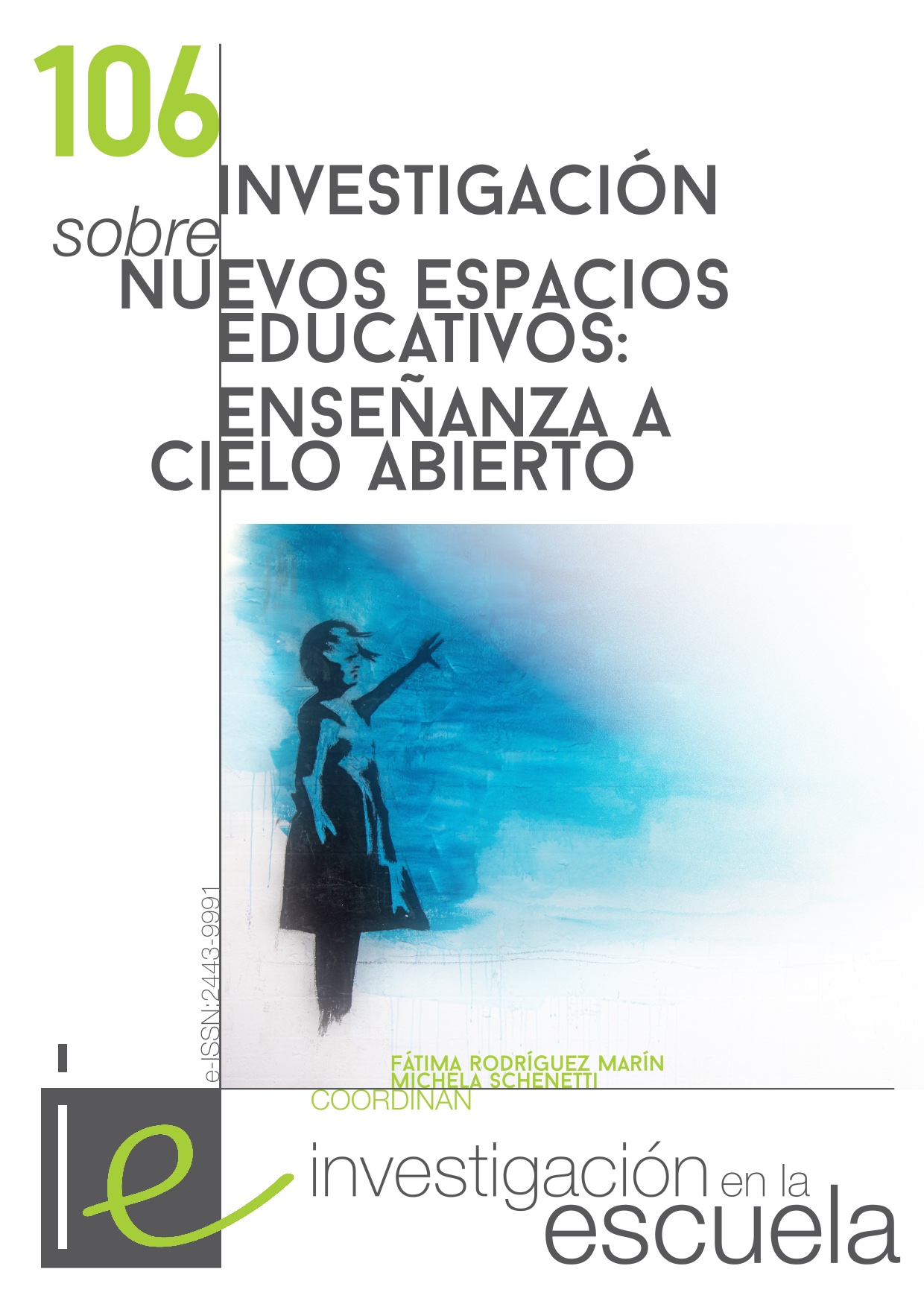Reconnect with nature. Attitudes and perceptions about the outdoor education of Early Childhood Education and Primary Education teachers
DOI:
https://doi.org/10.12795/IE.2023.i106.05Keywords:
Outdoor education, teaching and training, teachers, perceptionsAbstract
The purpose of this work is to know the teachers' perceptions about outdoor education. There are bibliographic findings that highlight the benefits that contact with nature has for child development, however, few teachers practice this educational approach with their students. The results of an investigation are presented where its participants, teachers of Early Childhood and Primary Education, express their opinions about the learning that they believe can be generated in nature and the barriers and limitations on this educational approach. The study concludes that the lack of training, time and interest are the main causes of the shortage of outdoor experiences that take place in the educational centers of the teachers participating in the study.
Downloads
References
Calvo-Muñoz, C. (2014). Niños y Naturaleza, de la teoría a la práctica. Medicina naturista, 8(2), 131–136. 10.36510/learnland.v12i1.981
Castell, C. (2020). Nature and health: a necessary alliance. Gaceta Sanitaria, 34(2), 194–196. 10.1016/j.gaceta.2019.05.016
Castillo, M. y Gamboa, R. (2013). Desafíos de la educación en la sociedad actual. Revista Electrónica Diálogos Educativos, 12 , 55–69.
Dietze, B., & Kashin, D. (2019). Perceptions that early learning teachers have about outdoor play and nature. LEARNing Landscapes, 12(1), 91–105.
Ernst, J., & Tornabene, L. (2012). Preservice early childhood educators’ perceptions of outdoor settings as learning environments. Environmental Education Research, 18(5), 643–664. 10.1080/13504622.2011.640749
Fernández, M. (2013). El aprendizaje difuso y el declive de la institución escolar. Revista de la Asociación de Sociología de la Educación, 6(2), 150–168.
García, T. (2003). El cuestionario como instrumento de investigación/evaluación. Página del Proyecto de Apoyo para Profesionales de la Formación (PROMETEO) de la Junta de Andalucía, 28. http://www.univsantana.com/sociologia/ElCuestionario.pdf
Harris, F. (2017). The nature of learning at forest school: practitioners’ perspectives, Education 3-13, 45(2), 272-291. 10.1080/03004279.2015.1078833
Hawxwell, L. (2019). You only need a potato peeler and tarpaulin – perceptions of outdoor learning from primary education trainees. TEAN journal, 11(1), 106–115.
Hueso, K. (2012). Mejores personas para un planeta mejor: El proyecto pedagógico al aire libre “Saltamontes”, pionero en España. Conama - Congreso Nacional Del Medio Ambiente, 2–12. http://www.conama2012.conama.org/conama10/download/files/conama11/CT 2010/1896699911.pdf
Jidovtseff, B., Kohnen, C., Belboom, C., Dispa, C., & Vidal, A. (2021). Outdoor education practices in belgian preschools and relationships with both environmental and personal factors. Journal of Physical Education and Sport, 21(1), 530–536. 10.7752/jpes.2021.s1058
Karsten, L. (2005). It all used to be better? Different generations on continuity and change in urban children’s daily use of space. Children’s Geographies, 3(3), 275–290. 14733280500352912
Largo-Wight, E., Guardino, C., Wludyka, P.S., Hall, K.W., Wight, J.T., & Merten, J.W. (2018). Nature contact at school: The impact of an outdoor classroom on children’s well-being. International Journal of Environmental Health Research, 28(6), 653–666. 10.1080/09603123.2018.1502415
López-Gil, M. (2016). Apren-red: internet como dinamizador del aprendizaje. Journal for Educators, Teachers and Trainers, 7(2), 142–154.
Louv, R. (2008). Last Child in the Woods: Saving Our Children From Nature-Deficit Disorder. Algonquin Books.
McDonough, P. (2009). TV viewing among kids at an eight-year high. Recuperado de https://www.nielsen.com/us/en/insights/article/2009/tv-viewing-among- kids-at-an-eight-year-high/
Miles, M.B., & Huberman, A.M. (1994). Qualitative data analysis. A new sourcebook of methods. Sage Publications.
Ofcom (2013). The Comunications Market. Report 2013. Ofcom.
Pérez, J. (2019). El trabajo: la transición de la modernidad sólida a la líquida: una aproximación al pensamiento sociológico de Zygmunt Bauman. SCIO. Revista de Filosofía, 17, 79–105.
Prensky, M. (2001). Digital Natives, Digital Immigrants. Part 1. On the Horizon (MCB University Press), 9(5), 1-6. 10.1108/10748120110424816
Rabazas, T. y Sanz, C. (2020). La escuela al aire libre. Tendencias Pedagógicas, 35, 153–158. https://revistas.uam.es/tendenciaspedagogicas/article/view/tp2020.35.RP35
Ríos, J.M., & Brewer, J. (2014). Outdoor Education and Science Achievement. Applied Environmental Education and Communication, 13(4), 234–240. 10.1080/1533015X.2015.975084
Savery, A., Cain, T., Garner, J., Jones, T., Kynaston, E., Mould, K., Nicholson, L., Proctor, S., Pugh, R., Rickard, E., & Wilson, D. (2017). Does engagement in Forest School influence perceptions of risk, held by children, their parents, and their school staff? Education 3-13, 45(5), 519–531. 10.1080/03004279.2016.1140799
Sañudo, L.E. (2006). La ética en la investigación educativa. Hallazgos, 6, 83-98.
Stan, I., & Humberstone, B. (2011). An ethnography of the outdoor classroom - how teachers manage risk in the outdoors. Ethnography and Education, 6(2), 213–228. 10.1080/17457823.2011.587360
Valentini, M., & Donatiello, P. (2021). Outdoor education as a way of life. Journal of Physical Education and Sport, 21(1), 618–623. 10.7752/jpes.2021.s1072
Downloads
Published
How to Cite
Issue
Section
License
Copyright (c) 2023 Investigaci´ón en la Escuela

This work is licensed under a Creative Commons Attribution-NonCommercial-ShareAlike 4.0 International License.
Authors who publish in this journal accept the following conditions:
- Authors retain copyright and grant the journal the right of first publication, with the work registered under a Creative Commons Attribution-NonCommercial-ShareAlike 4.0 International License (CC BY-NC-SA 4.0), which allows third parties to use the published work, provided that proper acknowledgement is given; the authorship of the work and first publication in AVANCES are mentioned; the material is not used for commercial purposes; and, if you create other material from the original material (e.g. a translation), you must distribute your contribution under this same licence as the original.
- Authors may enter into separate and additional contractual arrangements for non-exclusive distribution of the version of the article published in this journal (e.g., inclusion in an institutional repository or publication in a book) as long as they clearly indicate that the work was first published in this journal.
- Authors are allowed and encouraged to publish their work on the Internet (e.g. on institutional or personal websites) before and during the review and publication process, as it may lead to productive exchanges and to a wider and faster dissemination of the published work (see The Effect of Open Access).
Accepted 2023-07-12
Published 2023-07-17
- Abstract 873
- PDF (Español (España)) 797



